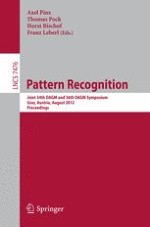2012 | Book
Pattern Recognition
Joint 34th DAGM and 36th OAGM Symposium, Graz, Austria, August 28-31, 2012. Proceedings
Editors: Axel Pinz, Thomas Pock, Horst Bischof, Franz Leberl
Publisher: Springer Berlin Heidelberg
Book Series : Lecture Notes in Computer Science
